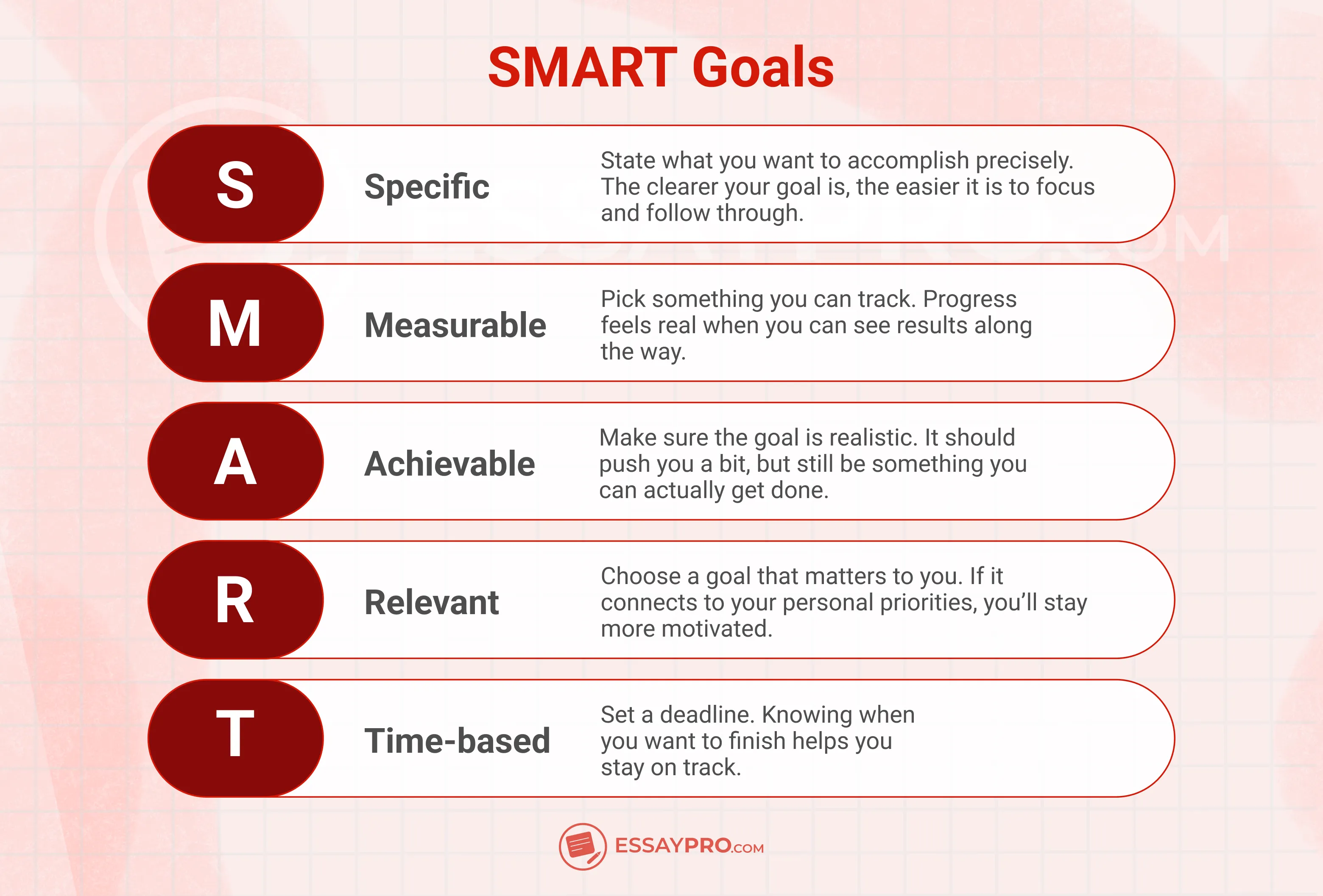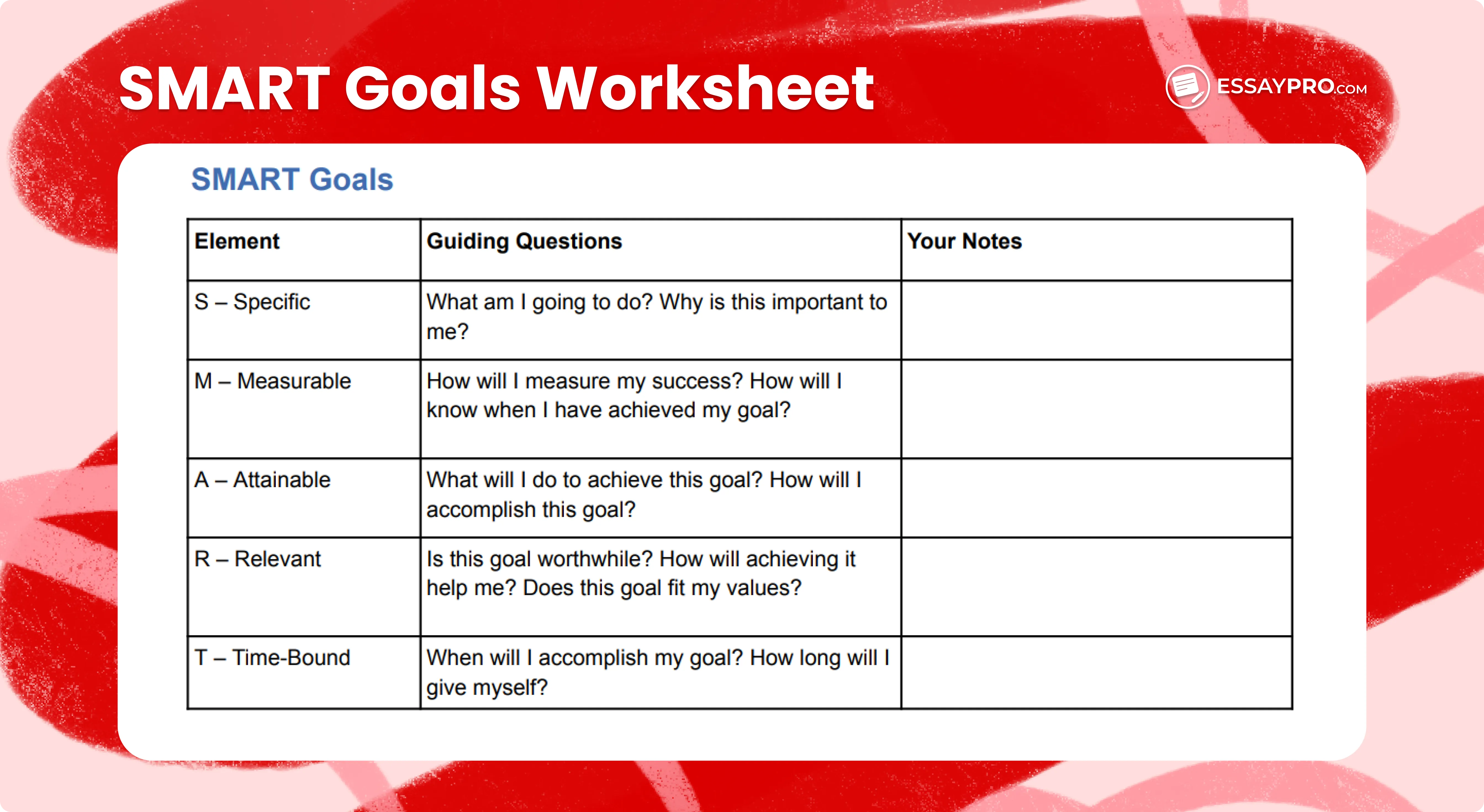Most goals fall apart because they're built on ideas alone, with zero structure. When there's no clear path, it's easy to drift or give up halfway altogether. SMART goals fix that. Instead of guessing your next move, you already know what to do because your plans already have shape. Here are a few quick steps for creating SMART goals:
- Be specific about the result
- Set a way to measure success
- Keep your goal realistic
- Choose something that matters to you
- Add a clear deadline
This guide will walk you through each step. And if getting through that pile of assignments sitting on your desk is part of your objectives, EssayPro's custom term paper writing service can help you get closer to your goals.
Key Takeaways
- Clear goals are easier to stick with.
- Small steps make big goals manageable.
- Writing down your goals turns plans into action.
- Checking in regularly keeps your progress steady.
- Staying connected to your "why" keeps you motivated.
What Are SMART Goals?
The SMART acronym means Specific, Measurable, Achievable, Relevant, and Time-bound. These are the five checkpoints that turn your broad goals into a manageable action plan. A SMART goal also keeps your focus tight - you don't have to wonder what progress looks like or when you've reached it. Each step is built in. Here's a quick example:
"I will improve my writing by spending 30 minutes each weekday working on drafts. I'll submit one polished essay per week for the next two months."
This isn't just a nice intention. It's clear. It's measurable. It has a structure.


How to Write SMART Goals Step by Step
Vague goals leave too much room for guessing. Creating a SMART goal will help you break your goals down into simpler parts so you know exactly how you'll get to what you're aiming for. Each step matters in the SMART method. Here's how to do it right:

- Start with something specific
- Find a way to measure your progress so you can track it
- Make sure the goal feels realistic
- Choose something meaningful
- Add a time limit so you have a finish line
S: Specific
The first part of a SMART goal is being specific. A goal won't work if it's too vague. Saying you want to "do better" doesn't give you anything solid to work with. That means getting clear about what you're trying to do (and what it involves). Ask yourself:
- What exactly do I want to accomplish?
- What steps will it take to get there?
- Who or what is involved?
For example: "I want to raise my biology grade by doing flashcard reviews and meeting with my tutor once a week."
M: Measurable
Next comes measurable. A goal means nothing if you can't tell if you're moving forward. A SMART objective needs a way to track progress. Try asking:
- How will I know if it's working?
- What can I count and track along the way?
- What does success look like?
Example: "I'll track my quiz scores each week and aim for an average of 85% by the end of the semester."
A: Achievable
The third part is about keeping your goal achievable. This part of the SMART criteria ensures your goal is realistic and achievable with your resources. Here's what to ask:
- Can I reasonably do this with my current schedule?
- Do I have what I need to start?
- Does this feel manageable rather than overwhelming?
Go with something like, "I'll write 500 words per day and finish the first draft in two weeks." Still a challenge, but one you can actually do.
R: Relevant
A goal only works if it means something. Relevant goals help you connect your objectives to something that actually matters to you. Plus, when a goal feels personal, it's much easier to stay motivated. Ask yourself:
- Why do I care about this right now?
- What does this help me work toward?
- Is this the right time to focus on this?
T: Time-based
Last comes the part that keeps the goal moving: a deadline. Time-based goals add structure. They stop your plan from dragging on forever. With the SMART framework, this part keeps things somewhat urgent and clear. Think about:
- When do I want to finish this?
- What mini-deadlines can I set along the way?
- How can I pace this without cramming?
Instead of saying, "I'll work on my application soon," say, "I'll complete all five applications before the 20th of next month, working on one each week."
Check also: How to grow your career in journalism.
Are SMART Goals Always the Right Fit?
SMART goal setting brings structure to your plans when you need a clear timeline. But it's by far not universal. Some situations call for flexibility or simply some space to explore, things that setting SMART goals doesn't always allow. Let's look at two sides of the coin and decide when this approach can be useful.
Why SMART Goals Work Well
When you've got defined objectives in mind, having a clear plan really makes it easier to stay on track. SMART goals give you exactly that kind of structure, the one that allows you to follow through without second-guessing every step.
- They keep things focused. You know where to put your energy.
- Progress feels easier to track. A SMART goal gives you concrete checkpoints that show how far you've come.
- They help with time management. Having a deadline means you avoid last-minute stress.
- You stay realistic. With this method, you aim for something doable, not just something that sounds productive.
- They support motivation. Smaller steps feel manageable, so you're more likely to keep going.
Where SMART Goals Fall Short
The SMART objectives can be ideal for already structured plans, but some goals need room to grow. Being overly specific in such cases can ultimately backfire, so it's best to find a different approach.
- They can feel too rigid. Some goals aren't meant to be broken into boxes; they need flexibility.
- Some ideas take time to define. Forcing a structure too soon can interrupt the process of figuring things out.
- It's easy to overlook bigger-picture thinking. Focusing on concrete steps can distract from reflection.
- Short timelines might create pressure. Deadlines are useful, but they don't always leave room for unexpected changes.
- They don't always fit emotional or personal growth goals. Internal progress is harder to track on a checklist.
SMART Goals Examples
It's one thing to understand the SMART method. Carrying it out in action is completely different. Let's take a look at concrete examples and see how a well-structured goal can work in different fields.
Business Growth
- Goal: Increase online sales by 12% by September 30 by running two email campaigns and improving product pages.
- Why it works: The goal is specific (sales increase), measurable (12%), and time-based (set deadline).
Team Collaboration
- Goal: Raise project completion rates to 95% by December 1 by holding weekly check-ins and using a shared task board to track progress.
- Why it works: It sets a clear target, includes practical tools for follow-through, and has a set timeline.
Academic Writing
- Goal: Write ten strong conclusions for practice essays in six weeks by dedicating 30 minutes each weekday.
- Why it works: It focuses on writing a good conclusion by setting a specific target and incorporating it into a daily routine.
Education Support
- Goal: Help a special education student learn 15 new sight words in 8 weeks using daily flashcard sessions and two reading blocks per week.
- Why it's SMART: It's targeted and paced to fit the student's learning needs.
Nonprofit Fundraising
- Goal: Raise $50,000 by December 31 through three local events and a social media pledge drive.
- Why it's SMART: The amount is specific, and the plan is actionable. It lines up with the nonprofit's year-end goals and gives them time to adjust if needed.
SMART Goals Worksheet
Once you have figured out how you will write your goals step by step, challenge yourself by doing something with what you have learned. This is where the SMART goals worksheet will come in handy.
To make things even easier, we’ve prepared a simple goal setting worksheet for students that you can use right away.

This is a basic tool to help students map out steps toward the overall goal. Instead of 'I will study more', the student can write down specifically what, when and how they will actually study more.
Instructions for using:
- Clearly write your goal.
- Re-evaluate your goal against each of the SMART components (Specific, Measurable, Achievable, Relevant, Time-bound).
- Revise until the goal meets all five criteria.
- Monitor your progress and revise accordingly.
What to Do After Creating Your SMART Goals
Real progress happens in what you do next after you write SMART goals. Below are a few practical tips to help you follow through with the plans you put on paper.
Set Weekly Checkpoints
Don't wait until the last target date to figure out if things are working. Break your goal into smaller tasks you can tackle each week. It will also give you an added bonus of feeling good about your productivity along the way.
Create a Visual Tracker
Use whatever works: a planner, a whiteboard, even a sticky note on your mirror. As long as your goal is visible, it doesn't matter what you use for tracking. When the progress is right in front of you, it's easier to stay focused without overthinking every step.
Build It Into Your Routine
Find a natural spot for your goal in your daily routine. If you're writing more, fit it in during your coffee break. Studying for an exam? Block out time after dinner. Little habits like this are what turn short-term goals into real progress.
Check In With Yourself
Take a few minutes at the end of the week to look back. What worked? What didn't? What needs to change? Just do a quick recap of your week to keep things moving in the right direction.
Remember Why You Started
If things start feeling repetitive, take a step back and reconnect with the bigger picture. Think about what this goal is leading toward: if writing a statement of purpose ties into an important career move, it will help to remember why you initially started. That reminder can bring back your focus when things feel off.
Keeping Your Goals Actionable
SMART goals work because they turn vague ideas into something solid. When every part of your goal is clearly laid out, it feels easier to follow through (and way less overwhelming). Here's a quick reminder of what to keep in mind as you set your SMART goals and stick with them:
- SMART is a method that helps you set focused goals you can actually follow through on.
- A strong goal includes a way to measure progress and sets a clear finish line.
- Once the goal is written, break it into smaller parts that fit into your routine.
- Keep an eye on how things are going so you can adjust if needed.
- Stay connected to the reason you started. It helps you keep moving when motivation dips.
EssayPro can take pressure off whenever sticking to your goals starts to feel like a struggle. If you're dealing with some technical subjects, just ask, 'Do my math homework,' for our professionals to step in and put you back on the right track.
Struggling With The First Steps?
EssayPro's expert academic writers can help you get started on your tasks on the right foot.
FAQ
What Are the 5 Steps to a SMART Goal?
The five steps follow the SMART method: start with something specific, make sure it's measurable, keep it achievable, choose something relevant to your needs, and give it a deadline.
What Does the S Stand for in SMART Goals?
The "S" stands for Specific. It means your goal should be clearly defined. You need to know exactly what you're aiming for so you can focus your effort in the right direction.
How to Set and Achieve SMART Goals?
Start by writing your goal using the SMART format. Break it into smaller tasks and track your progress as you go. Fit your goals into your daily routine so you can work on them regularly. Check in with yourself often, and stay focused on your reason for setting the goal.

Annie Lambert
specializes in creating authoritative content on marketing, business, and finance, with a versatile ability to handle any essay type and dissertations. With a Master’s degree in Business Administration and a passion for social issues, her writing not only educates but also inspires action. On EssayPro blog, Annie delivers detailed guides and thought-provoking discussions on pressing economic and social topics. When not writing, she’s a guest speaker at various business seminars.
- University of Massachusetts Dartmouth. (2011). Creating S.M.A.R.T. Goals. Umassd.edu. https://www.umassd.edu/fycm/goal-setting/resources/smartgoals/
- University of California. (2016). SMART Goals: a How to Guide. University of California. https://www.ucop.edu/local-human-resources/_files/performance-appraisal/How+to+write+SMART+Goals+v2.pdf







